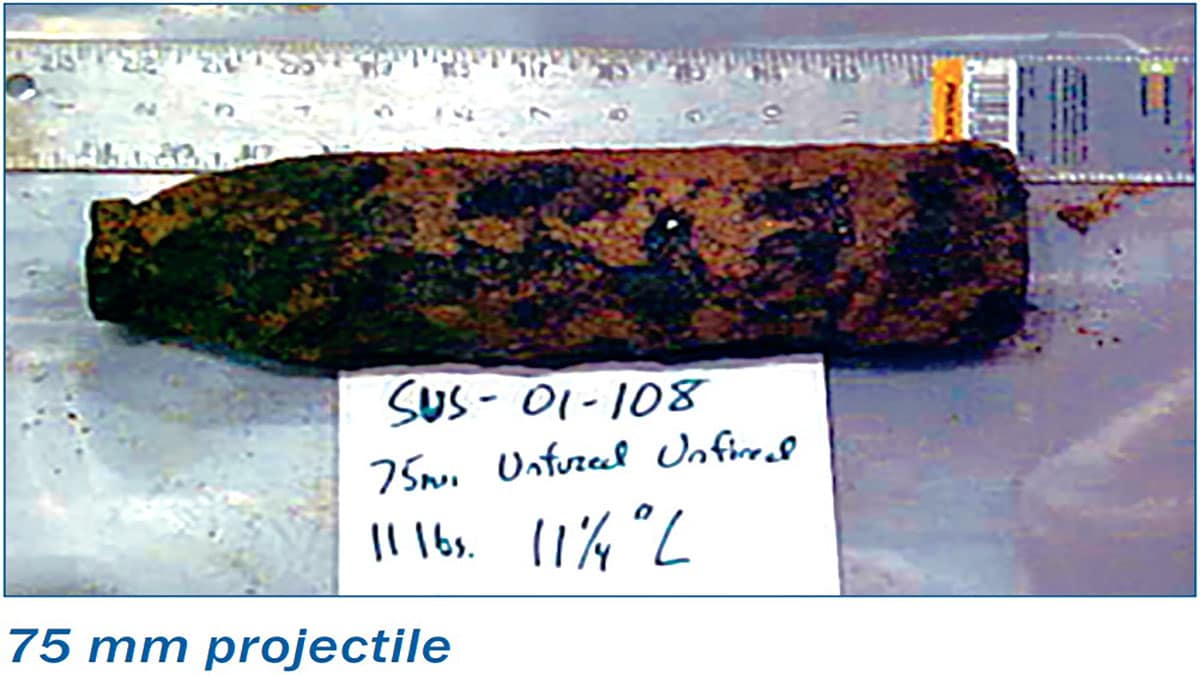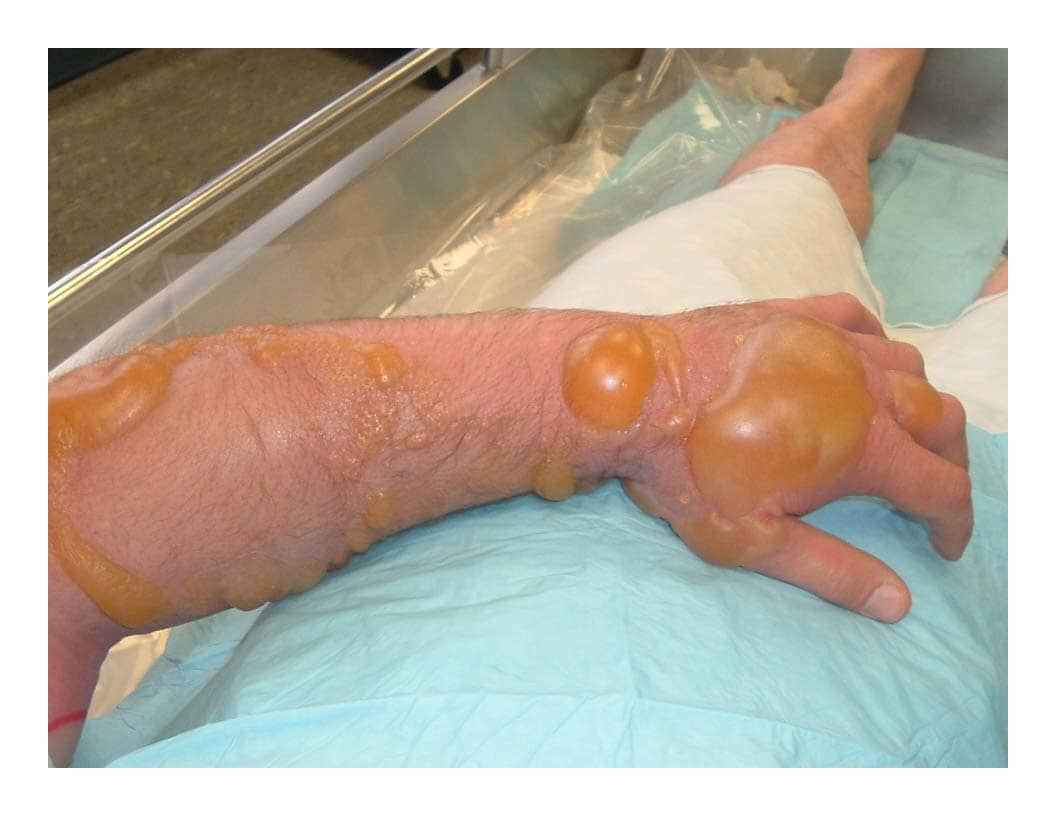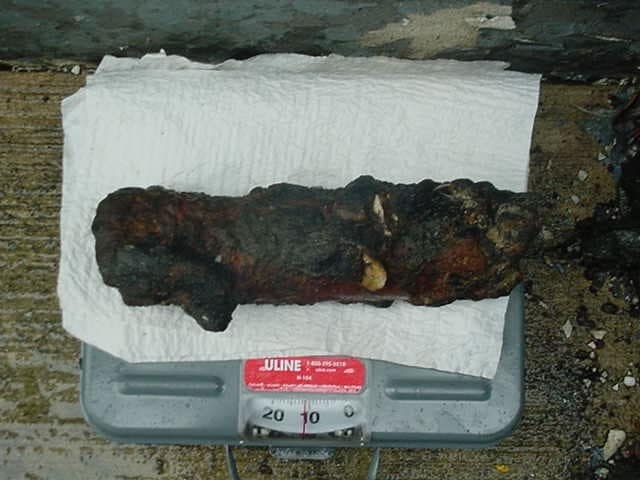What to know
Learn how to prepare for and what to do when you encounter chemical munitions while at sea.

What to do if you recover a munition while at sea
You dredged up a munition along with your catch. These munitions often contain warfare chemicals, and they can be encountered anywhere at sea, not just charted hazardous areas. The U.S. Army Technical Center for Explosives Safety provides guidance on how to RECOGNIZE, RETREAT from, and REPORT munitions at sea in their maritime recovered munitions guidance.
Maritime Recovered Munitions Guidance

Chemical munitions and other chemical warfare material
Before the 1970s, disposal munitions at sea was common. Conventional munitions of every type and chemical munitions with various chemical agent fills were all sea-disposed. Commercial fishing, clamming, and dredging operations should be prepared to respond when munitions are brought up from the ocean.
Vessels should prepare a munitions response kit of necessary supplies in advance and provide crew with appropriate training on how to protect themselves. Crew who perform jobs where catch or other items are brought up from the ocean should be trained on how to
- recognize munitions
- properly handle munition
- safely put on and remove personal protective equipment (PPE)
- decontaminate potentially contaminated surfaces
- recognize signs and symptoms of exposure
- report the incident
CDC, along with other partners, developed tools for commercial fishermen encountering chemical munitions to train on the items above and includes a resource card that can be taken with them when seeking medical attention. The card also provides the signs and symptoms of exposure.
The tools were provided to industry and stakeholders, including National Oceanographic and Atmospheric Administration, United State Coast Guard, United States Food and Drug Administration, and various state public and environmental health agencies that may become involved in the incidents.

How to prepare for recovering chemical munitions or other chemical warfare material
If jettisoning the munition, use a two person team to place munition in a plastic tote and lift to gunwale. You should toss both the tote and munition overboard.
If munition is brought onboard and if you must handle it, you should follow these recommendations to protect yourself:
Isolate: You should keep unneeded crew members upwind and as far away as possible. The captain should steer the vessel into the wind to help minimize vapor exposure.
Decide on action: You should quickly decide if you will need to handle the munition. The longer the munition is exposed to ambient temperatures the more likely it is to leak. Beware of any leaking substances—vapors are toxic and liquids can cause burns. If crew members are not trained to properly handle munitions and how to safely wear PPE, or if you do not have the appropriate equipment, stop and request assistance from the U.S. Coast Guard on channel 16 (156.800 MHZ) or by calling (800) 424-8802.
Protect responding crew members: Crew members who are properly trained and will approach and handle the munition should wear appropriate PPE to protect their skin from leaking liquids. PPE should be put on (donned) in the following order:
- Inner pair of gloves
- Suit
- Apron
- Face shield
- Outer pair of gloves
Take action: Crew members trained to handle munitions should jettison or secure the munition as necessary.
Decontaminate: Decontaminate equipment and individuals that are potentially contaminated with liquid that leaked from the munition by physically removing the warfare chemical with soap and water. Make sure the wash solution and rinse water do not enter the vessel or come into contact with you or your coworkers. The wash solution and rinse water should be handled as hazardous waste and disposed of in accordance with applicable standards. Follow your company's policy regarding how to determine when equipment is properly decontaminated.
- Equipment: Wash and rinse contaminated surfaces with soap and water (using cold or warm water).
- People: If you or a coworker are exposed to liquid from the munition, remove all clothing and place into plastic bags and then seal. Thoroughly wash and rinse the contaminated skin using a soap and water solution. You should wash the individual starting at their head and working your way down to their toes. Rinse the individual's eyes with clean water for at least 20 minutes. Be careful not to scratch or break the skin and cover all open wounds. Cover the individual to prevent shock and loss of body heat. Exposed individuals should seek immediate medical attention.
Remove PPE: After handling the munition and decontaminating surfaces, remove PPE and place into plastic bags and then seal. When removing PPE, the outer surface should be treated as potentially contaminated and care should be taken to not touch the outside surface, roll PPE downward, and avoid pulling PPE off over the head. Remove (doff) the PPE in the following order:
- Outer pair of gloves
- Apron
- Face shield
- Suit
- Inner pair of gloves
PPE should be placed in a plastic bag, sealed as well as possible, and disposed of in accordance with applicable standards.
Alert: Notify the U.S. Coast Guard on channel 16 (156.800 MHZ) or by calling (800) 424-8802.
Look: Look for symptoms. Symptoms can happen right away or up to 48 hours after exposure. Symptoms include sudden weakness, burning eyes, skin blisters, trouble breathing, redness, and burning skin. If you suspect you were exposed, go to the emergency room.
Protect the public: Follow your company's policy regarding the catch. Fishing vessels that have come into contact with chemical agents must not bring their catch ashore until it has been checked and released by the appropriate state's department of environmental health. Sea life contaminated by chemicals is unsuitable for human or animal consumption.
The following items are recommended to have onboard in a munitions response kit:
• Steps for Treating a Suspected Recovered Chemical Munition
• Resource card to take when seeking medical care: Signs and Symptoms of Exposure to Sulphur Mustard
• Chemical protective suit that provide protection against chemical warfare agents (such as a suit made out of Tychem® F, Tychem® BR/ Tychem® Responder®, Tychem® TK, Trellchem® HPS, Trellchem® VPS with taped seams)
• Chemical-resistant apron
• Inner gloves (such as nitrile rubber)
• Chemical-resistant outer gloves that provide protection against chemical warfare agents (such as butyl rubber, Viton® HPS/Butyl rubber, Silver Shield/4H® HPS)
• Face shield
• Disposable plastic waste bags 10 mills thick (or double trash bags 6 mills thick)
• Soap
• Brush for decontamination
• Waterproof container to store the kit in
